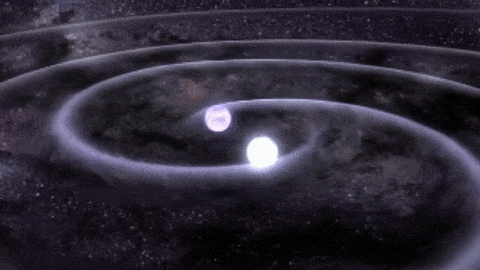My congratulations to the LIGO team on their discovery of gravitational waves. It is a result that is at least as important as the discovery of the Higgs Boson. It includes the first observation of gravitational waves, and of two black holes colliding and merging. With LIGO's increased sensitivity, we can expect many more detections, all improving our knowledge about how the universe works.
These experimental observations are consistent with my theoretical work on black holes in the 1970s. As a theoretical physicist, I have spent my life contributing to our understanding of the universe. It is thrilling to see predictions I made over 40 years ago such as the black hole area and uniqueness theorems being observed within my lifetime.
http://www.independent.co.uk/news/science/stephen-hawking-congratulates-gravitational-waves-discovery-and-says-we-can-expect-many-more-a6868151.html
...
Gravitational waves provide a completely new way at looking at the Universe. The ability to detect them has the potential to revolutionise astronomy. This discovery is the first detection of a black hole binary system and the first observation of black holes merging.
https://www.theguardian.com/science/2016/feb/11/gravitational-waves-discovery-i-was-right-says-stephen-hawking

A history of the search for gravitational waves
1915 - Albert Einstein publishes general theory of relativity, explains gravity as the warping of spacetime by mass or energy
1916 - Einstein predicts massive objects whirling in certain ways will cause spacetime ripples—gravitational waves
1936 - Einstein has second thoughts and argues in a manuscript that the waves don't exist—until reviewer points out a mistake
1962 - Russian physicists M. E. Gertsenshtein and V. I. Pustovoit publish paper sketch optical method for detecting gravitational
waves—to no notice
1969 - Physicist Joseph Weber claims gravitational wave detection using massive aluminum cylinders—replication efforts fail
1972 - Rainer Weiss of the Massachusetts Institute of Technology (MIT) in Cambridge independently proposes optical method for detecting waves
1974 - Astronomers discover pulsar orbiting a neutron star that appears to be slowing down due to gravitational radiation—work that later earns them a Nobel Prize
1979 - National Science Foundation (NSF) funds California Institute of Technology in Pasadena and MIT to develop design for LIGO
1990 - NSF agrees to fund $250 million LIGO experiment
1992 - Sites in Washington and Louisiana selected for LIGO facilities; construction starts 2 years later
1995 - Construction starts on GEO600 gravitational wave detector in Germany, which partners with LIGO and starts taking data in 2002
1996 - Construction starts on VIRGO gravitational wave detector in Italy, which starts taking data in 2007
2002–2010 - Runs of initial LIGO—no detection of gravitational waves
2007 - LIGO and VIRGO teams agree to share data, forming a single global network of gravitational wave detectors
2010–2015 - $205 million upgrade of LIGO detectors
2015 - Advanced LIGO begins initial detection runs in September
2016 - On 11 February, NSF and LIGO team announce successful detection of
gravitational waves
http://www.sciencemag.org/news/2016/02/gravitational-waves-einstein-s-ripples-spacetime-spotted-first-time